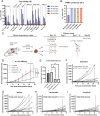Exploiting the intrinsic misfolding propensity of the KRAS oncoprotein
- PMID: 36812200
- PMCID: PMC9992772
- DOI: 10.1073/pnas.2214921120
Exploiting the intrinsic misfolding propensity of the KRAS oncoprotein
Abstract
Mutant KRAS is a major driver of oncogenesis in a multitude of cancers but remains a challenging target for classical small molecule drugs, motivating the exploration of alternative approaches. Here, we show that aggregation-prone regions (APRs) in the primary sequence of the oncoprotein constitute intrinsic vulnerabilities that can be exploited to misfold KRAS into protein aggregates. Conveniently, this propensity that is present in wild-type KRAS is increased in the common oncogenic mutations at positions 12 and 13. We show that synthetic peptides (Pept-ins™) derived from two distinct KRAS APRs could induce the misfolding and subsequent loss of function of oncogenic KRAS, both of recombinantly produced protein in solution, during cell-free translation and in cancer cells. The Pept-ins exerted antiproliferative activity against a range of mutant KRAS cell lines and abrogated tumor growth in a syngeneic lung adenocarcinoma mouse model driven by mutant KRAS G12V. These findings provide proof-of-concept that the intrinsic misfolding propensity of the KRAS oncoprotein can be exploited to cause its functional inactivation.
Keywords: KRAS; oncogene; peptide; protein aggregation; protein folding.
Conflict of interest statement
The authors have organizational affiliations and stock ownership to disclose F.R. and J.S. are scientific founders of Aelin Therapeutics and members of its scientific advisory board and own stock options of Aelin Therapeutics. E.B., B.S., F.C., V.L.W. and D.V.d.V. are employees of Aelin Therapeutics and own stock options of Aelin Therapeutics. The authors have patent filings to disclose, F.R. and J.S. are listed as inventors of patents filed by VIB/KU Leuven/UGent/VUB and licensed to Aelin Therapeutics describing the TPA technology. The Pept-ins described in this manuscript are included in patents filed by Aelin Therapeutics and VIB/KU Leuven with F.C., E.B., J.S. and F.R. listed as inventors.
Figures




References
Publication types
MeSH terms
Substances
Grants and funding
LinkOut - more resources
Full Text Sources
Medical
Miscellaneous

